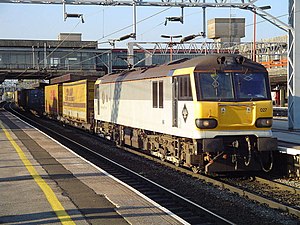British Rail Class 92
| British Rail Class 92 | |||||||||||||||||||||||||||
|---|---|---|---|---|---|---|---|---|---|---|---|---|---|---|---|---|---|---|---|---|---|---|---|---|---|---|---|
 | |||||||||||||||||||||||||||
| |||||||||||||||||||||||||||
| |||||||||||||||||||||||||||
| |||||||||||||||||||||||||||
The Class 92 is a dual-voltage British railway locomotive which can run on 25 kV AC from overhead wires or 750 V DC from a third rail. It was designed specifically to operate services through the Channel Tunnel between Britain and France. Eurotunnel indicates the Class 92 locomotive as the reference for other locomotives which railway undertakings might want to get certified for usage in the Channel tunnel.[2]
Design
The fleet of 46 locomotives was built by a consortium of Brush Traction and ABB Traction, which is now part of Bombardier for British Rail. Parts construction was sub-contracted, with only final construction and commissioning being undertaken at Brush's erecting shops at Loughborough between 1993 and 1996 (First unit was produced from 1992, and was finished in April 1993)
The bodyshells, shared with the similar looking Class 60 diesel locomotives but with a modified front end, were fabricated by Procor of Horbury and delivered pre-painted in then standard triple grey livery.[3] Propulsion is provided by two ABB traction converters using GTO devices, with control via an ABB MICAS-S2. Maximum power is 6760 hp (5 MW) on 25 kV or 5360 hp (4 MW) on 750 V; with a tractive effort of 360 kN.
The locomotive is fitted with both rheostatic and regenerative brakes, in addition to standard westinghouse air brake equipment. A Train Bus is fitted to enable two locomotives to work in multiple formation, either double-heading or push-pull passenger train with a Driving Van Trailer or DBSO.
Operations
Prior to introduction to service, two locomotives (92001 and 92002) were extensively tested at the Czech Railway's test track at Velim near Kolin. One locomotive was temporarily moved from here to Vienna Arsenal for climatic testing.
The majority of the class are named after European composers and writers. Post-privatisation the ownership was split between EWS, European Passenger Services (Eurostar (UK)) and SNCF.
During 2000 Eurostar (UK) offered their seven members of the class (92020 / 021 / 032 / 040 / 044-046) for sale being surplus to requirements with the non commencement of sleeper services through the Channel Tunnel. However no buyer could be found so they have now been decommissioned and stored at Crewe International electric depot. Five of these locomotives have now been purchased by Eurotunnel to be used by their Europorte 2 rail freight undertaking for short haul rail traffic in France.[1]
In 2009 a project is undertaken with the aim of allowing the class to be modified for operations on High Speed 1: ie with TVM signalling. Freight operations are expected to begin in 2010.[4]
The class is also notable in that the last train ever to travel under British Rail, the 2315 service from Dollands Moor to Wembley on 21 November 1997, was hauled by Class 92 92003 Beethoven.[5]
Gallery
-
92002 at Vienna Arsenal in August 1994 undergoing cold weather testing (-25 Degrees C)
-
92001 with test car with DC pantograph, and adaptor wagon with metro type shoegear on the VUZ test track at Velim, Czech Republic in November 1994
-
92015 D. H. Lawrence running light engine through Stafford in August 2005 sporting original livery but with the addition of a large EWS "three beasties" logo to its sides
-
92027 George Eliot at Stafford
-
92001 Victor Hugo at Crewe Works on 1st June 2003. This is one of only two Class 92 locomotives to carry full EWS livery
-
92027 George Elliot at Doncaster on 4th September 2007
References
- ^ a b Development for Europorte 2: Eurotunnel buys five Class 92 locomotives
- ^ "Eurotunnel Network Statement - 2008 Working Timetable -" (PDF). Eurotunnel. 2008-03-18. Retrieved 2008-12-23.
RUs [Railway Undertakings] may use as a frame of reference the Class 92 locomotive, which is currently used for freight trains in the Channel Tunnel. A technical description of this locomotive can be obtained from the Director of Railway Development, whose contact details are given in Section 2.1 of the Network Statement.
- ^ rolling stock : class 60
- ^ Freight trains set to use High Speed 1, Thursday 16 April 2009 rail.dbschenker.co.uk
- ^ "EWS". Class 58 Locomotive Group. Retrieved 2009-03-30.





